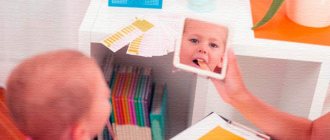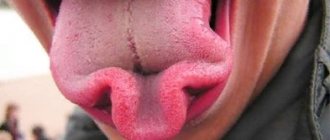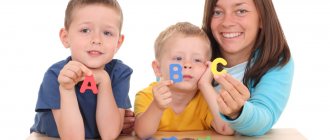Examination of sound pronunciation in preschool children
Natalia Obraztsova
Examination of sound pronunciation in preschool children
The formation of sound pronunciation usually ends by the age of five, five and a half years. By this age, the child must pronounce all the sounds of his native language correctly, that is, use them correctly in his own speech and not mix them with each other.
The simplest way to examine sound pronunciation is this : the child is shown pictures and asked to name them. In words, the sound should be in different positions: at the beginning, in the middle and at the end of the word. Then they ask the child to come up with a short phrase with this word. If it’s difficult for him, they help him. If it was not possible to find the necessary pictures, then simply ask the child to repeat the words with different sounds .
The most common speech defects in preschool children are sound pronunciation disorders . Usually the following groups of sounds are violated: whistling (s, s', z, z', ts, hissing (sh, zh, h, sch, sonorant (l, l', p, r,, j, back-lingual (k, k' , g, g', x, x', voiced (c, h, g, b, d, g, soft (t,, d,, n,)
.
In some children, only one group of sounds , for example, only hissing sounds or only back-lingual ones. Such a violation of sound pronunciation is defined as simple (partial, or monomorphic. In other children of sounds are disturbed simultaneously , for example, hissing and back-lingual or whistling, sonorant and voiced. Such a violation of sound pronunciation is defined as complex (diffuse, or polymorphic.
In any of the above groups, three forms of sound :
- distorted pronunciation of sound .
- absence of sound in the child’s speech , i.e. inability to pronounce it
- replacement of one sound with another available in the phonetic system of a given language.
Violations of sound are designated by terms derived from the names of Greek letters corresponding to the basic sound of each group :
- phonetic disorders of whistling and hissing sounds are called sigmatisms, and phonemic disorders - parasigmatisms - from the name of the Greek letter sigma, denoting the sound s ;
- phonetic violations of the sounds l and l' are called lambdacisms, and phonemic violations - paralambdacisms - from the name of the Greek letter lambda, denoting the sound l ;
- phonetic violations of the sounds p and p' are called rhotacisms, and phonemic violations - pararotacisms - from the name of the Greek letter rho, denoting the sound p ;
- phonetic violations of the sound j are called iotacisms, and phonemic ones - paraiotacisms - from the name of the Greek letter iota, denoting the sound ;
- phonemic - parakappacisms - from the name of the Greek letter kappa, denoting sound to phonetic disorders of back-lingual sounds are called kappacisms.
Disorders of groups of voiced and soft sounds do not have special terms - they are called:
- voicing defects;
— softening defects.
To determine the nature of the violation of a particular group of sounds (whistling, hissing, etc.), you need to clearly know these varieties, and also develop the skills and abilities necessary for examining sound pronunciation :
the ability to listen, that is, to isolate defective sound from the speech stream and determine how it is disturbed;
the ability to record the work of the organs of the articulatory apparatus when pronouncing a disturbed sound : to see which movements do not work, what participation the lips, lower jaw, and each part of the left and right half of the tongue take;
skills and abilities to communicate with children suffering from speech disorders (the ability to call a child for a conversation, during which the pronunciation of sounds in the speech stream , in individual words, and when pronounced in isolation) is checked.
It is advisable to adhere to a certain check procedure so as not to miss anything and to collect the necessary material, on the basis of which it will be possible to draw up a work plan to correct the child’s sound pronunciation .
When conducting an individual examination , the speech therapist records all the children's in a speech card indicating the date of the examination . In each child’s individual notebook, one or two pages are allocated to describe the results of the examination . There, the teacher notes the presence of gross, visible defects in the structure of the articulatory apparatus, then records the state of sound pronunciation
Let's take a closer look at the procedure for examining sound pronunciation :
1) Examination of speech sounds in children begins with a thorough check of isolated pronunciation. The following groups of sounds :
- vowels A, O, U, E, I, Y;
- whistling, hissing, affricates (С, Сь, З, Зь, Ц, Ш, Ш, Шch)
;
- sonorant sounds (P, Rb, L, L, M, мь, Н, Нь)
;
- voiceless and voiced pairs (P-B, T-D, K-G, F-V)
in hard and soft sounds
(P-B, T-D, K-G, F-V)
;
- soft sounds in combination with different vowels, i.e. PI, PYA, PE, PYU (also Дь, Мь, Ть, Сь)
.
During the examination, it is necessary to note the nature of the child’s pronunciation of isolated sounds , indicating the nature of the violation (for example, S-Sh (replacement)
; WHAT, etc.
Tasks consisting of repeated repetition of one sound , since this creates conditions that facilitate articular switching from one sound to another .
Also useful for speech therapy analysis is repetition of two sounds or syllables , which implies a clear articulatory switching (for example, KAP-PAK)
.
First, sounds that differ sharply from each other in articulation are presented, then closer ones.
At the same time, there are cases when children do not succeed in motor switching from one sound to another and, instead of repeating the initial sound of the second pair, they perseverate the previous one. The appearance of an “averaged”
articulations (for example, T and D are conveyed by the same semi-voiced ones, T and Ть are semi-soft).
2) Then the speech therapist finds out how the child uses sounds in speech . When checking, attention is paid to substitutions, distortions, confusions, and omissions of sounds . For this purpose, the pronunciation of words is examined . Sets of pictures are presented, including words from the sounds . Words of different syllabic structures are selected. Particular attention is paid to how these sounds are pronounced in sentences.
3) The ability to pronounce sounds in sentences consisting of correctly pronounced sounds and defective ones .
sound defects are grouped according to phonetic classification.
Games and gaming techniques for examining sound pronunciation in children :
1. “Magic cap”. On the playing field there are “holes” where pictures are drawn, the names of which contain the sound . The magic cap falls into one of the holes. The child names the corresponding picture.
2. "Helicopter". The round dial is divided into several sectors. In each of them a corresponding picture is drawn, in the middle of the dial there is an arrow. The child, moving the arrow, stops it at any picture, calling it.
3. “The Cheerful Fisherman.” The box contains pictures, the names of which contain the sound . The child uses a fishing rod to “catch” pictures and name them.
4. “Who is the most attentive?” There are envelopes on the table, each of them contains a part of a cut picture. The child takes out individual parts, looks for the missing elements, puts them together and names the picture.
5. “Magic chamomile.” On each petal of the chamomile there are pictures with the sound . The child, “opening” the petals, names the corresponding pictures.
6. “Mysterious chest.” The beautifully decorated chest contains toys whose names include the sound . The child takes the toy by touch, guesses it and names it.
7. “Let’s decorate our Christmas tree.” A small artificial Christmas tree is placed on the table. The child, at the request of the speech therapist, hangs pictures of toys on it and names them.
8. Game “On the contrary”. The speech therapist throws a ball to the child, names a forward syllable with a given sound , and the child, returning the ball, names a reverse syllable with the same sound .
9. “Find your match.” Pictures depicting one or more identical objects are laid out on the table; children take any picture they like, then, at the speech therapist’s signal, they split into pairs so that one child has pictures with one object, and the other has two or three. Then each of the children names their picture.
10. “Collect an autumn bouquet.” In the group there is a “tree growing”, on which the outlines of autumn leaves are attached. On their reverse side there are pictures with the sound being examined . Children walk around the group and listen to music. As soon as the music stops, the speech therapist says: “The leaves are falling, flying, leaf fall is coming.” Children quickly take the leaves and approach the speech therapist. Then everyone names the picture drawn on their piece of paper. The leaves are placed in a vase.
BIBLIOGRAPHY
1. M. F. Fomicheva. Raising children correct pronunciation, - M., -1999.
2. L. N. Efimenokova. Formation of speech in preschool children . - M., 1995.
3. E. I. Negnevitskaya, A. M. Shakhnarovich. Fundamentals of the theory and practice of speech therapy. – M., 1998
4. Basics of speech therapy with a workshop on sound pronunciation : Textbook. aid for students avg. ped. schools, institutions / M. F. Fomicheva, T. V. Volosovets, E. N. Kutepova, etc.; Ed. T.V. Volosovets - M.: Publishing House
, 2002. - 200 p.
5. Gribova, O. E. Technologies for organizing speech therapy examination : methodological manual / O. E. Gribova. - M.: Iris-press, 2005. - 96 p.
6. Nishcheva N.V. System of correctional work in a speech therapy group for children with general speech underdevelopment. – St. Petersburg, 2005.
It has been established that no later than 5 years it is necessary to begin to identify all the deficiencies in sound pronunciation. Why?
It goes without saying that a small child cannot pronounce all speech sounds correctly, since his articulatory apparatus is not yet strong and has not developed sufficiently. Distorted pronunciation of preschoolers under 4-5 years of age is considered normal and is called age-related or physiological tongue-tiedness. And only after 4–5 years (this limit may change depending on the conditions of the child’s speech development) is a violation of sound pronunciation considered a pathology. Thus, it is from this age that speech therapy work to eliminate dyslalia should begin.
But before you begin classes on developing correct sound pronunciation, you need to examine the children’s speech.
Examination of the state of sound pronunciation in children
It is very important to promptly and completely examine the speech of a child with pronunciation problems. By timely detection of speech pathology, we mean a speech therapy examination, which is carried out no later than 4 years of age.
When performing a speech therapy examination of children with dyslalia, it is necessary first of all to study in detail the structure and mobility of the organs of the articulatory apparatus. Then carefully examine the state of sound pronunciation. In addition, it is important to determine the state of phonemic awareness. Let us dwell on each type of speech therapy examination separately.
An examination of the articulatory apparatus begins with checking the structure of all its organs: lips, tongue, teeth, jaws, palate. At the same time, the speech therapist notes whether there are any defects in their structure, whether it corresponds to the norm.
During the examination, the following anomalies can be detected in the structure of the moving and fixed parts of the articulatory apparatus:
lips - thick, fleshy, short, inactive;
teeth - sparse, crooked, small, outside the jaw arch, large, without gaps between them, with large gaps, missing upper and lower incisors;
bite - open anterior, open lateral, deep, shallow;
jaws - the upper one is moved forward, the lower one is moved forward;
the palate is narrow, high (the so-called “Gothic”) or, conversely, flat and low;
tongue - massive, small or, conversely, very large; shortened bridle.
Next, the mobility of the organs of the articulatory apparatus is checked. The child is asked to perform various imitation tasks (following the speech therapist) or speech instructions, for example: lick his lips with his tongue, try to reach his nose, chin, left and then right ear with his tongue; click your tongue; make the tongue wide, spread out, and then narrow, raise the tip of the protruding tongue upward and hold it in this position for a long time; move the tip of the tongue first to the left corner of the lips, then to the right, changing the rhythm of movements; stick your tongue out as far as possible, and then pull it deep into your mouth; stretch your lips forward like a tube, and then stretch them into a wide smile; do these exercises alternately, changing the rhythm of movements; push the lower jaw forward, then pull it back, open your mouth wide, and then close your jaws, etc.
We check the child’s sound pronunciation with self-learning and methodological material on the topic
Rules for checking pronunciation:
The child should calmly, without pressure, repeat words and sounds after you (pronounce them without excessive pressure).
Listen carefully to the sound your child makes in isolation. Have him repeat it several times. Sometimes children, using incorrect locations of their speech organs, imitate the full sound of some sounds quite well, so that a violation of their pronunciation may go unnoticed by an untrained ear. For example, when pronouncing the sounds [s], [s], [z], [z], [ts], the child’s tongue ends up between the teeth.
The child must correct such sounds with the help of a speech therapist, because their erroneous pronunciation will make it difficult to fully pronounce other sounds. In the phonetic system of any language, the methods of pronouncing sounds are, as it were, “matched” to each other from the point of view of the greatest convenience of switching the speech organs from sound to sound. That is why the incorrect pronunciation of a sound often becomes more distinguishable in words when it interacts with other consonant sounds.
Therefore, if in doubt, check how the child pronounces the sound in words with confluences (when several sounds of consonants or vowels are in a row) of consonant sounds (for example, for the sound [w] - chestnut, mouthpiece, for the sound [s] - chisel, hint) . When pronouncing such words, firstly, the incorrect pronunciation of the sound becomes more obvious, and, secondly, a certain pause appears between the consonant sounds in a combination, which is necessary for the transition from one articulation to another, which is not related to it.
When checking pronunciation, do not sit opposite your child. At this moment he should not see how you pronounce sounds. Better sit next to him. It is advisable to record the speech examination on video equipment.
The examination itself should take place in a relaxed atmosphere and take no more than 15 to 20 minutes.
It is better to arrange the examination in the form of a table: in 1 column – the sound being tested; in 2 – write as you pronounced it in isolation; in 3 – as pronounced in words, write down the pronunciation of these words; in 4 – write down the spoken sentence with all errors. For example:
| Subject sound | in isolation | in words | in sentences |
| With | tongue between teeth | When pronouncing all the words, the tongue was between the teeth. chisel (chisel), podkaka (tip). | Sonya eats from Mickey. (Sonya eats from a bowl) the tongue was between the teeth. |
Exercises to check sound pronunciation:
- Following you, the child should repeat the sound several times in an isolated position (that is, separately - [s]).
- Following you, he should repeat words where this sound is in different positions (at the beginning, middle and end of the word).
It must be borne in mind that voiced paired consonant sounds at the end of a word, as well as before voiceless consonants, are deafened (that is, [zh], for example, will sound like [sh]; the word knife is like nosh, the word leg is like noshka, etc. P.).
- Repeat sentences rich in words with the sounds being tested.
Words and sentences to check pronunciation:
X - move, collar, ear, ottoman, moss, ah
XH - hit, hake, flies, perfume. A fly sits on the ear.
K – cat, whip, window, letter, side, bull. The cat is sitting on the window.
Kb – kit, pile, questionnaire, layout. A whale sleeps in the ocean.
G – beep, lip, din, leg, mango, carriage, paper. I'm traveling in a carriage. Mom takes out the paper.
Gb - Gena, sore throat, hippopotamus. Gena has a sore throat. Gena sees a hippopotamus.
F - veil, candy wrapper, pound, muff, cafe. Faina has a veil and muff.
F - Fenya, hairdryer, film, coffee, ottoman. The fairy has a hairdryer. There is a hairdryer on the ottoman.
B – Vanya, bath, water, cotton wool, gadfly, two, sofa. Vanya is sleeping on the sofa.
Vb – vein, coil, broom, kiwi, penguin. Venya sees a penguin.
Th – mud, shadow, kitten, bow. Tyoma has a kitten with a bow
T – Tanya, stomp, notes, duck, cat, whale. The duck has ducklings.
Дь – grandfather, Dima, cadet, dressed. Grandfather dresses Dima.
D – house, melon, boa constrictor, fashion, can. There is a can under the house. There is water in the can.
Y - iodine, yogi, Maya, T-shirt, capelin, clip, fight, howl. Maya, put on a T-shirt.
L - flax, Lida, Lena, Lyuba, viburnum, Valya, flask, raspberry, stranded, blizzard. Lena loves viburnum, and Valya loves raspberries. Stranded in the ocean.
L - Lada, boat, moon, saw, tin, pilaf, Klava, cloud, head, flask, Kalmyk, head, ox, chalk, balalaika, bells. Lada is sitting in a boat. Klava has milk in a can. The hammer fell into the boat. Mila wrote a letter to Klava.
C – sled, scoop, owl, sock, sand, machine, herd, glass, pedestal, scales, piece, bowl, mask, nose, dog, pump, sauce, pine. The dog has a piece of meat. Sonya is sitting under the pine trees. Sonya eats from a bowl. Stas has a glass of juice.
SB - Semyon, canopy, hay, geese, carries, seven, goose, Vasya, all. Vasya is covered in hay. Semyon grazes seven geese.
Z – Zoya, splinter, teeth, mimosa, goat, vase. Zoya is herding a goat. Mom puts mimosa in a vase.
Zi – winter, Zina, newspaper, raisins, shop, owner. Zina is carrying newspapers. The owner has raisins in the store.
C – chain, flowers, gypsy, price, sheep, singer, button, dance, chick. An acacia tree is blooming near the house. The sheep has a long chain. A chick is sitting in the nest. A singer is singing on stage.
Ш - hat, fur coat, tire, wardrobe, seamstress, car, porridge, bear, mouthpiece, car, target, Misha, Dasha, shower, carcass, finish, checkers, cones. Masha washes her neck and ears in the shower. Pasha has cones, and Masha has checkers. A seamstress sews a pillow.
F – toad, beetle, belly, knives, dinner, pajamas. Zhenya and Zhanna are having dinner. The beetle is buzzing and cannot get up. He is waiting for someone to help him
H – suitcase, seagull, tea, watch, boy, cookie, daughter, dot, butterfly, ball, oven, daughter, night, stuffed animal, Chukchi. The boy is carrying a suitcase. Helen drinks tea with cookies. Daughter eats a donut.
Shch – pike, puppy, brush, vegetables, thing, horsetail. I drag the pike, I drag it. I'll release the pike. The puppy eats horsetail.
R – Roma, Raya, frame, hands, gate, ram, crab, ladder, square, brother, certificate, cake, tiger, Makar, axe, megaphone, program. Makar carries an ax to repair the fence. The ram stands under the gate. The sailors are walking along the ladder.
RUB – Rita, turnip, belt, birch, lilac, gingerbread, Seryozha, door, beast. Rimma is making jam. Irinka takes the lantern.
There are several types of sound pronunciation disorders:
- The sound may be missed completely. Then, when repeating words, instead of a sound, the child utters an unclear vowel or semi-consonant sound, sometimes slightly iotized (barn - sa-y-ay or sa-y-ay) or skips the sound completely (sa-ay). When pronouncing hissing and whistling sounds, this semi-consonant sound is accompanied by an aspirated noise. When trying to pronounce a sound in isolation, the child will also produce some kind of indistinct sound or will not be able to pronounce anything.
— Instead of one sound, the child pronounces a fully sounding other sound. For example, instead of [p], he pronounces [l] or [th]. This is called replacement.
— A child can replace one sound with another sound that sounds inferior. For example, the sound [w] is replaced by the incorrectly pronounced sound [s].
- A child can replace a hard consonant with a soft pair (for example, instead of [l] say [l]). This is called softening. If you find a softening of some sounds in the child’s speech, be sure to check whether he softens all the consonant sounds that can be softened.
— The child may pronounce the sound distorted. That is, in his speech the sound is quite recognizable, but it sounds abnormal for the Russian language. For example, instead of the Russian-speaking [r], the child pronounces a guttural, grating [r], or instead of the sound [sh], he pronounces a certain noisy hissing sound similar to [sh].







